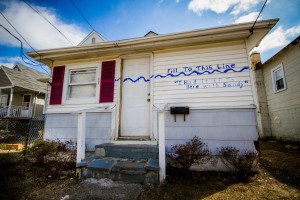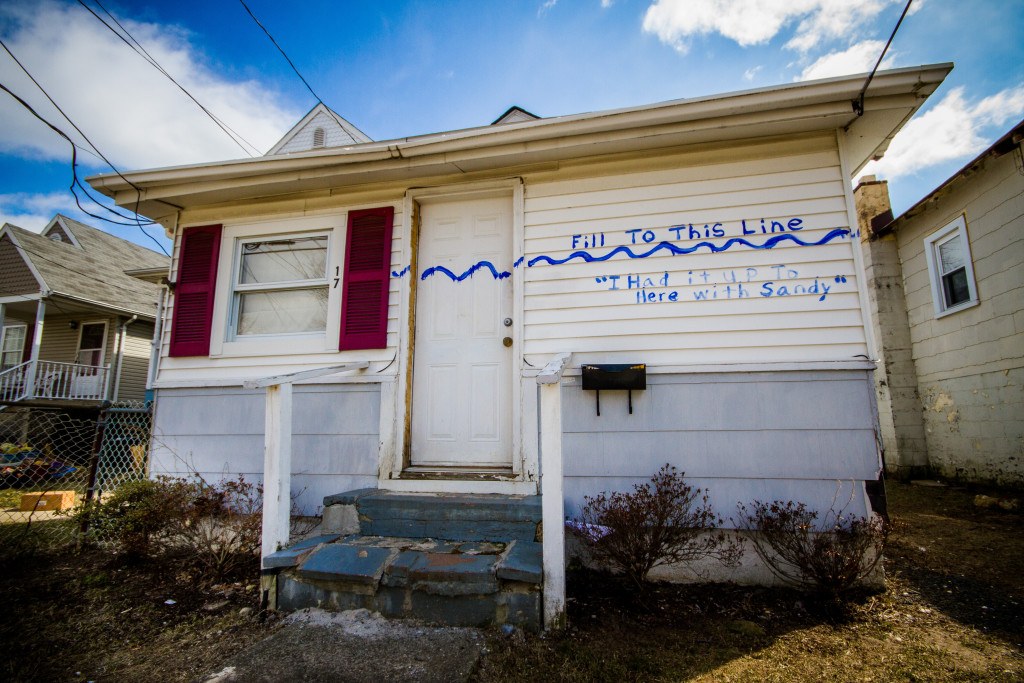An appraiser sent by the state recently assessed the value of Bob and Pat Smith’s house, nearly a year after floodwaters from Superstorm Sandy reached midway up the living room walls. Like the 75 other homeowners living near the South River who qualify for buyouts, the Smiths are waiting to hear how much the state will offer to tear down their home of 47 years and have them relocate out of harm’s way.
Hundreds of New Jersey residents are like the Smiths, displaced by the worst storm in state history and eligible for a buyout but unconvinced the offer will be high enough for them to move – and uncertain what to do next.

After the late October storm forced thousands of residents from their low-lying homes, Gov. Chris Christie announced plans to accelerate the flood buyout program known as Blue Acres by having federal storm-aid funds help cover costs. The administration targeted 1,300 properties in tidal areas and the Passaic River basin at a cost of $300 million. Three-quarters of the money will come from FEMA’s Hazard Mitigation Grant Program, with state Department of Environmental Protection covering the rest.
So far, 272 homes in Sayreville and South River have been identified for purchase in neighborhoods that were extensively flooded by the Raritan and South rivers. The cost of buying those homes and returning the property to wetlands is $55.1 million.
The program is voluntary, but the governor’s intent is to buy up contiguous parcels, not create a checkerboard of homes and vacant lots.
In the first Sayreville neighborhood targeted, the pot of money to buy out 129 eligible homes is $29.5 million. Fifty-four property owners have received offers ranging from the low-$200s to the low-$300s, borough business administrator Dan Frankel said. Eleven homeowners have accepted, and one has said no, according to DEP spokesman Larry Hajna.
The first closings could happen as soon as this month.
That leaves 42 owners who are either undecided or displeased with the offer.
“We’re having a couple of hiccups, which we’re working though,” Frankel acknowledged. “The appraisal process has been a big bone of contention. Emotionally, the residents are shot.”
The offers are based on a home’s pre-Sandy value minus any post-storm aid the homeowner has received.
Property owners dissatisfied with the state’s offer can hire their own and file an appeal. Before that happens, however, the DEP agreed to review the offers it has made in Sayreville to see if adjustments need to be made.
Many of the residents have experienced previous home flooding, and some have replaced, remodeled and rebuilt several times. But moving also presents a wrenching choice that can be both financially vexing and emotionally challenging.

Ultimately, the homeowners may have little choice but to accept the state’s offer.
Homeowners with a mortgage are required to carry flood insurance, which could become unaffordable if they refuse a buyout, said South River administrator Fred Carr. The only other way to mitigate the flood hazard is to lift a home so it complies with FEMA’s new flood maps; in Sayreville and South River, that could mean raising a house by as much as 15 feet, depending on where it’s located. Grants of as much as $150,000 are available.
Christie announced last week that FEMA has approved another $13.8 million for buyouts of 67 more tracts in Sayreville. In neighboring South River, $11.9 million has been allocated for 76 parcels, with appraisals scheduled to be done by Friday, Hajna said.
State officials held preliminary meetings in Woodbridge and Old Bridge, but no announcements about buyouts in those towns have been made.
Meanwhile, Pat Smith is planning to host Thanksgiving dinner in her newly remodeled dining room. The Smiths don’t know where they’ll be living at this time next year, but they don’t think it will be on Water Street.
Was this article valuable?
Here are more articles you may enjoy.


 California Again Delays Wildfire Protection Rules for Homes
California Again Delays Wildfire Protection Rules for Homes  NYT, Chicago Tribune Sue Perplexity AI as Copyright War Rages On
NYT, Chicago Tribune Sue Perplexity AI as Copyright War Rages On  Verlan Files Subro Suit Against Georgia Chemical Plant After $20M Payout on Fire
Verlan Files Subro Suit Against Georgia Chemical Plant After $20M Payout on Fire  Losses Top $20 Billion in Asia Floods as Climate Risks Grow
Losses Top $20 Billion in Asia Floods as Climate Risks Grow 